Last Updated on May 30, 2022 by The Tutor
How to Choose the Right Light Bulb
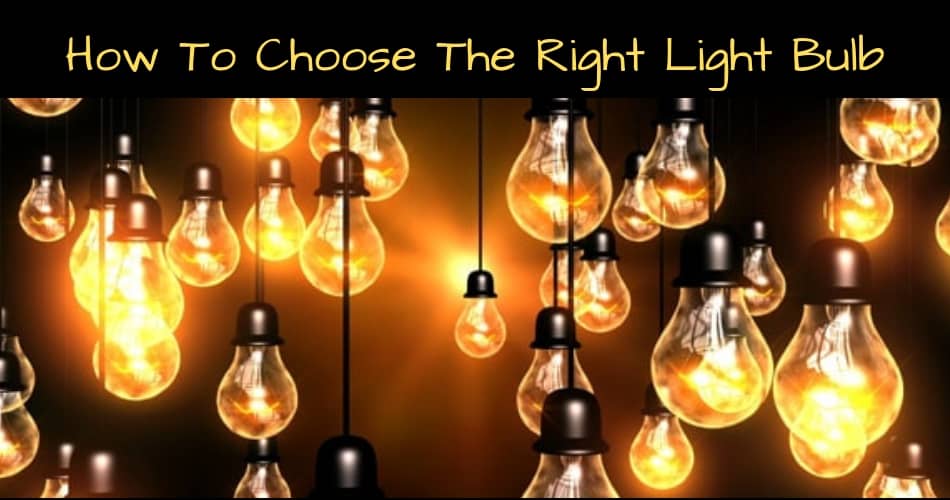
Learning how to choose the right light bulb is as important as selecting the perfect light fixture. Understanding your options and which ones match the room and the fixture is a critical element to lighting
Many homeowners do not know how to choose the right light bulb and they go to the local home improvement store and shop for a bulb that fits by price. Too often the bulbs are purchased without a clear understanding as to whether the bulbs will look right in your room or your light fixture.
We will take you through the method and things you need to consider when buying light bulbs for your home. At the end of the article I will show you how to read the label on the light bulb package to tie all of this together. When you are finished, you can view my recommended light bulbs at the bottom.
The Top Things to Consider When Choosing the Right Light Bulb
- Light Bulb Fitting Type
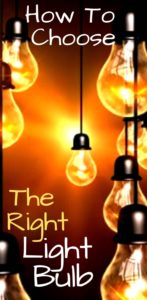
- Watts & Lumens
- Kelvin Color Temperature
- Bulb Type – Incandescent, Halogen, Fluorescent (CFL), and LED
- Where the Bulb Will be Used
- If it Will be Used with a Dimmer
Light Bulb Fitting type
Understanding your fitting type is the first thing you have to figure out before you choose the right light bulb. That is dictated by the fixture. You can either remove an existing light bulb to check our if the fixture is new, you can read the specs to see what fitting type your bulb needs to be.
The most common is the Edison Screw type of bulb. Even with the Edison screw type, there are a few size options within that. Have ever seen the skinny light bulbs from a chandelier and the fitting is much more narrow?. If you are wondering, yes this bulb was invented by Thomas Edison in the early 1900’s. The bulb to the left is the most common size E26 and the one on the right is the candelabra E12 which is the most common for chandeliers. 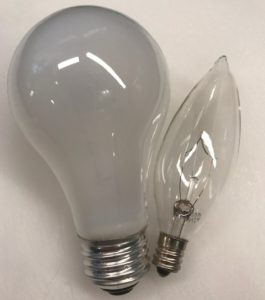
Another common light bulb fitting type is the GU10 fitting. It was designed first for halogen bulbs and now also available in LED. These don’t screw in but instead are installed with a slight push and then a turn to the right. This is a picture of what the end of a GU10 bulb looks like. I have a recessed lighting fixture in my bathroom ceiling (see below) that uses this bulb as well as the lights in my stove range hood.
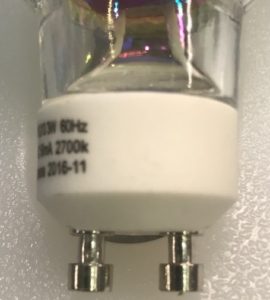
Choose the right Light Bulb with the Right Watts & Lumens
There is a direct relationship between the watts needed to power a bulb and the number of lumens that bulb will yield based upon the bulb type (LED, Fluorescent, Incandescent). What are lumens? There is a scientific definition that can more easily be explained like this. If you are familiar with horsepower in a gas motor, well lumens is measuring in candle power and each one of those equals one lumen.
Below is a chart that will give you an idea as to how the lumens increase.. 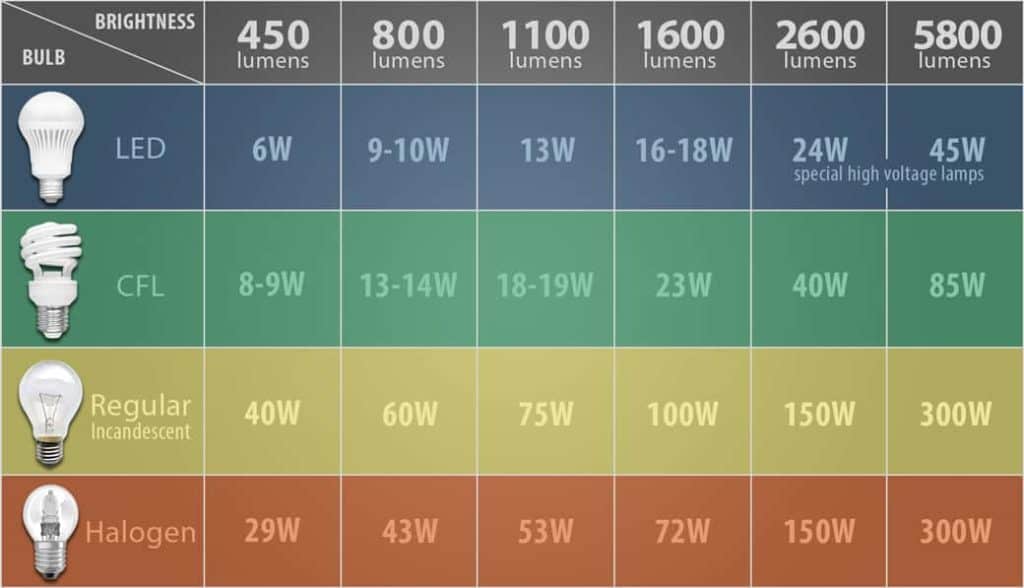
Courtesy LED Watcher
You can see that each bulb type will have a different yield when it comes to lumens. In the past when we only had incandescent bulbs and people used to shop only by the watts needed to power the bulb. They correlated watts with brightness. Now, with these other bulb choices you can see that it is no longer about the watts because lumens determine brightness. Watts now are just an indicator as to how much energy will be used to power each bulb
Now that you understand what lumens are, you need to determine how many lumens you need for the fixture or the room you are trying to light. For example, if you have a 12×16 family room with 6 recessed lighting cans in the ceiling, you may need to use bulbs that yield 800 lumens each. However, if you only had 4 recessed lighting cans in that ceiling, then you probably would need brighter bulbs in each.
Kelvin Color Temperature
The color temperature of each light bulb is measured in Kelvin units. You can read about the kelvin temperature scale here and learn completely how Kelvin color temperatures impact the type of light that the bulb will emit. This is a good education for you to have before you buy any light bulb.
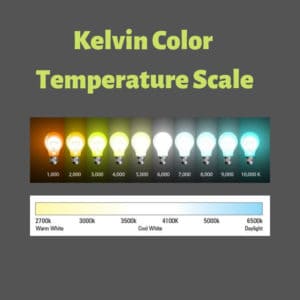
In short, the lower the kelvin temperature number, the more yellow (warm) the light will be. The higher the kelvin temperature number, the more blue (cold) the light will be. You can see from the scale above what I am talking about. This photo will just give you a basic idea. If you are not sure which temperature will look best in your room, then it would be a good idea to buy two or three different ones and see how the look.
Every light bulb package will indicate which color temperature the bulb is. These are the most common temperatures. (2700k – 3000k – 4000k – 4500k – 5000k) 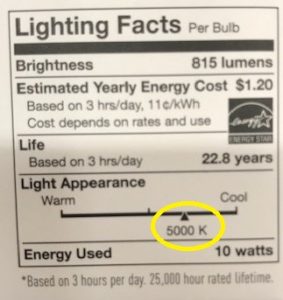
Type – Incandescent, Halogen, Fluorescent (CFL), LED
For the most part, you will be looking at these three options when choosing the right light bulb. However, for me the only choice for today and for the future is LED. This is an education process though so I will take you through all three types so that you can understand the differences.
Incandescent Light Bulbs – This is the old style light bulb that was most common for decades. It uses a thin wire filament inside of the bulb which gets heated up when the current flows through it. This extreme heating causes the filament to glow which in turn creates the light.
Incandescent bulbs are the most inefficient of the three in that they use the most watts to create the same lumens as the other two bulb types. They also do not last as long. Usually, that wire filament will burn and break well before a fluorescent or LED bulb will stop working. Most home improvement stores have a very small selection of these bulbs now. I will not even link to them for you to purchase.
Incandescent bulbs are not the right light bulbs and I recommend that you replace them immediately with LED bulbs.
Halogen Light Bulbs
A halogen bulb is also an incandescent bulb with a tungsten filament. That filament is sealed within a transparent cocoon that is filled with a mixture of gas and halogen. The benefit of the halogen bulb is that it has the ability to produce high levels of lumens. Off road vehicles often use halogen bulbs because of the intense brightness.
The negative here is they get extremely hot. I had a portable halogen shop light that used a halogen bulb. It would light up the entire backyard but if you touched the metal housing it would melt your skin from the heat.
In the home, a halogen bulb is just not very efficient. The heat is not as intense as the shop light I just referenced but hot enough to change the temperature in the room. Not efficient especially in the summer months if you are trying to keep the house cool.
Fluorescent (CFL) Light Bulbs – Fluorescent CFL (compact fluorescent light) bulbs are filled with a mercury based gas. When the electric current flows into the bulb, it ignites the mercury gas vapors. These vapors produce an ultra violet light which makes the coating on the inside of the bulb to glow.
These bulbs really were a great invention. They use much less energy than incandescent bulbs and last longer too. However, the problem is that if you break the bulb you risk being exposed to mercury. They are difficult to dispose of but your local home improvement store may have a collection box for them.
If you currently have fluorescent bulbs and they are working for you, then I recommend that you keep them and replace if and when they burn out. They are still relatively efficient and worth keeping for now if you have them.
LED Light Bulbs
LED means “light emitting diode”. It is a semiconductor that emits light when current flows through it and electrons within that semiconductor release energy in the form of photons… which is the light. Okay, now that we have the technical description aside, this is where lighting is at today.
I am sure at some point there will be some new invention but for now, LED lights are the present and the future of light bulb technology. They are the most efficient and they last the longest. The other advantage is they do not give off the heat that an incandescent or a halogen bulb will. Swapping out your bulbs with LEDs will also reduce the load on your wiring. This is even more important if you have aluminum wiring in the home.
Now, LED bulbs are made in virtually every style. Christmas lights are LED now which is great because they burn out much less frequently.
You can even find the LED old style filament bulbs. These look like the old filaments but they are LED giving the bulbs the old retro Edison style look as seen in the photo below.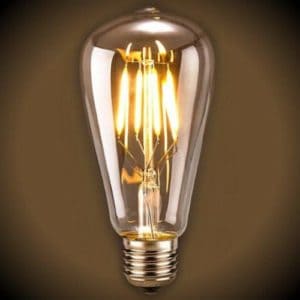
Where the Bulb Will be Used
There are so many different kinds of light bulbs and sometimes the location or type of use may have an impact on what bulb you select. In the past, I remember my father using the same 60 watt light bulb for a lamp in the bedroom that he used for a light in our kitchen ceiling.
The Right Light Bulbs for The Kitchen – There are so many different ways to light a kitchen and you will find that you will have multiple light fixtures too. In general, this is usually a room that needs a lot of light and often uses a kelvin temperature of at least 3500k.
You will find that your ceiling light bulbs will most likely be different than what you have in your pendant lights and certainly different than what you would use in under cabinet lighting. For the kitchen, make sure that all of the different lights you have are close to one another in the kelvin temperature scale. You would not want to use 4500k in your recessed lights and then 2700k in your pendants. They would not complement one another.
The Right Light Bulbs for The Bedroom – The bedroom tends to be a bit more simple and is often lit with bulbs that are 3000k for the ceiling and 2700k or 3000k for the lamps. If you have a task reading light, that may be a bit brighter. Similar to a kitchen, you want to harmonize the various temperatures so that you do not have stark contrasts.
I no longer like to use incandescent bulbs but if I did, the bedroom would be the only place to do it. They give off a nice warm glow for rooms where you want that cozy feeling.
The Right Light Bulbs for The Bathroom – Your bathroom will tend to have brighter lights than your bedroom. The temperatures will be up to 4000k and your vanity possibly colder than that. I am using an LED GU10 4000k bulb in the recessed lighting fixtures in the ceiling. The shower bulb is only 3000k because the colder bulb did not look good against the tile that we have in the shower.
Your vanity light bulbs will be the most difficult to select. When it comes to putting on makeup or shaving, you will need a colder temperature. Apparently, the temperature of the bulbs in my bathroom are not cold enough because my wife has been applying her makeup in front of the window with a small hand held mirror. Time to test a different light bulb
The Right Light Bulbs for The Family Room – This room can go in various directions especially if you have vaulted ceilings. The higher the ceiling, the more lumens you will need and also the colder the temperature. At the same time, if you also have table lamps and other smaller light fixtures, those will most likely be softer, warmer lights to add a comfortable mood to the room.
The other thing that may impact which bulbs you buy is the furniture that you have in this room. If you have a lot of wood or darker furniture, then a very cold bulb will not look right at all. This is another reason why you need to do some testing.
The Right Light Bulbs for The Garage – The garage is a place that just needs to be bright. In the old days, I remember the garage at home had a single 60 or 100 watt bulb in the ceiling. This was a two car garage with a ceiling light of about 15 feet. I am not sure how we could see anything in there at night. This is not just the case with older homes. Even new construction today has the wrong lighting in the garage and the builder just installs something that will keep you from bumping into things as you walk but that is about all.
For the garage, you need multiple fixtures in the ceiling with temperatures of at least 5000k minimum. Right now, I have four 96 inch fluorescent Sylvania bulbs that use 75W each and yield about 4000 lumens each. Still this is not enough and I am currently researching the best garage lighting so that I can make that one of my upcoming lighting projects. I will be switching to LED not only because it is more efficient but also when the garage is cold, the fluorescent bulbs flicker initially until they warm up after a few minutes.
I am recommending that you install new LED fixtures with as many lumens as you can.
The Right Light Bulbs for Outdoor Security
For outdoor security, you obviously want bulbs that are as bright as possible. That being said, if the light fixtures are always on outside and they are also providing basic lighting for your exterior, then you also want it them look good. This is where you will once again balance the temperature vs the lumens needed.
If you have security lights that come on with a motion sensor, then you can be less concerned with how the lights look when they are on. In this instance, you want a bright light that will make an intruder nervous enough to leave. An example of this is your motion sensor light in front of your garage. It seems like everyone has one of these.
Will it Be Used with a Dimmer?
Before you purchase any bulb you really need to determine whether you plan to use a dimmer for the fixture where the bulb will be used. Not every bulb is compatible with dimmers. In fact, not all dimmers are compatible with each bulb. I wrote a recent article on why LED lights buzz when dimmed. This should provide some insight as to what I am talking about.
After you determine whether you want to use a dimmer for the lights in question, then purchase the bulbs that are compatible. Keep in mind that each dimmer has a maximum total watt capacity. If you plan to use it for a whole series recessed lights for example, then you will need to add up the total watts of all of the bulbs and make sure they do not exceed the maximum watts for that dimmer. Another reason why you may want low energy LED light bulbs.
Related questions
What are lumens?
Lumens is how light output is measured. The higher the lumens, the more light you will get from a light source. In the past, light output of light bulbs were mistakenly measured according to how many watts that bulb consumed. Now, with other light options such as LED, lumens has become the measurement that has become mainstream.
What are the best light bulbs?
The best light bulbs are LED Edison style bulbs. They are the most energy efficient and versatile bulbs you can buy and they deliver a consistent light at all kelvin temperatures.
